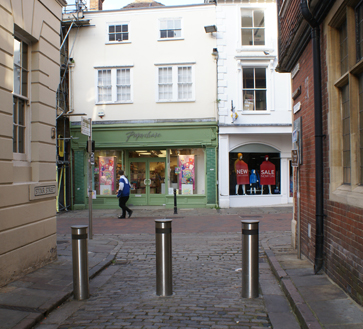A historic city centre that keeps out most or all traffic at peak times suits counter-terrorism and makes for safer walking for pedestrians – but whatever the urban planning, someone is not satisfied.
A recent report to the City of York Council’s executive meeting on November 18 stated that as part of a national strategic response to the threat from terrorism, the council, with North Yorkshire Police, ‘has developed proposals for protecting the central footstreets of York from attack via a hostile vehicle. It is intended to introduce barriers to prevent unauthorised vehicles from accessing the footstreets. This necessitates procedures for authorising and controlling access by any motor vehicles to enter the footstreets. Under current plans, blue badge holders would not be authorised to access the footstreets.’
As that shows, countering terrorism – in the jargon, creating a ‘sterile area’ by not allowing vehicles in a city centre in business hours – does come with a cost, meaning that the disabled cannot drive to park their own vehicles in disabled parking places outside shops or banks. Among others, the York Disability Rights Forum objected to what’s proposed.
As the report goes on to set out, security and counter-terrorism are one ingredient in wider urban planning. Other variables include ‘last mile delivery’, necessary to businesses inside the city walls; while the authorities look to reduce the volumes and impact of delivery vehicles, also in the name of ‘low carbon’. As the reference to blue badges suggests, also to be considered is access for the disabled. The report admitted that some partially sighted people or those with walking difficulties ‘used to rely on taxis to drop off in the city centre, but now taxi access has been removed, they cannot get close enough for facilities’.
Any city centre needs various users – vehicles, cycles and those on foot – to mingle safely. The report conceded that cycle theft is a problem ‘and many people are reluctant to leave their bike at the edge of the footstreet zone’. Yet the faster you travel, the safer you may feel; the report added that ‘some women say they feel safer cycling than on foot, especially when going out in the evening’.
There’s no need to re-invent the wheel; other places such as Winchester and Canterbury have similar issues, that the authorities have mitigated; and significantly the report went on to compare Chester, Bath and Cambridge. As a separate ‘community brief’ document on street accessibility said: “Chester is allowing access through a staffed barrier, while Bath has recently consulted on proposals to allow access to one of three protected areas using access controlled through CCTV cameras.”
Bath council’s ‘security zone’ bollards featured in the January edition of Professional Security magazine.
Besides, as in other places, the covid pandemic prompted changes to public space: York closed its city centre shopping streets to traffic to give more room for pedestrians, as enforced by covid marshals at barriers. The granting of pavement café licences also meant less space for traffic (popular according to a survey of residents in 2020; and central government has extended the streamlined pavement café license legislation, to support economic recovery from the pandemic, to the end of September 2022). That’s all of a piece with general urban transport policy regardless of the pandemic, which the report set out: ‘seeking to increase active travel and public transport use in York in general, and in particular for journeys to the city centre, and …. seeking to control general traffic intrusion into it, particularly given the broader policy requirements around transport decarbonisation’. Generally, to take away the local government jargon, that means wider pavements and narrower, one-way only carriageways for vehicles.
As in other historic town and city centres, that often draw tourist crowds, counter-terror mitigation has been advised for some years. In February 2018, police asked the city council ‘to consider new measures to reduce the risk of a vehicle as weapon attack in the footstreets’. Hence York has since had temporary (‘national asset’) hostile vehicle mitigation measures for what the council has termed ‘significant events in the footstreets’ such as barriers at the Christmas market. The problem as the report to the executive noted; ‘York has very tight streets’ making it hard to add any bollards, as delivery lorries – including cash in transit vans, which for crime prevention reasons want to park as near to the pick-up and drop-off point as possible – find it difficult enough to squeeze into the city centre as it is.
The report detailed the various human rights – such as of the disabled to equal access; but the report argued that in the wider public interest is ‘a positive duty on the state (i.e. public bodies) to protect life which is in essence at the heart of the counter terrorism measures’. In sum, ‘it has not been possible to find a way to deliver the safety benefits of the counter terrorism measures without causing the impact to parts of the disabled community’.
Photo by Mark Rowe; anti ram bollards, Canterbury city centre, summer 2021.









